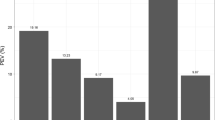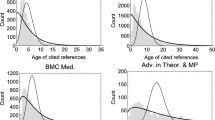Abstract
Two paradigmatic approaches to the normalisation of citation-impact measures are discussed. The results of the mathematical manipulation of standard indicators such as citation means, notably journal Impact Factors, (called a posteriori normalisation) are compared with citation measures obtained from fractional citation counting (called a priori normalisation). The distributions of two subfields of the life sciences and mathematics are chosen for the analysis. It is shown that both methods provide indicators that are useful tools for the comparative assessment of journal citation impact.



Similar content being viewed by others
References
Asai, I. (1981). Adjusted age distribution and its application to impact factor and immediacy index. Journal of the American Society for Information Science, 32, 172–174.
Beirlant, J., Glänzel, W., Carbonez, A., & Leemans, H. (2007). Scoring research output using statistical quantile plotting. Journal of Informetrics, 1(3), 185–192.
Bergstrom, C. T., West, J. D., & Wiseman, M. A. (2008). The eigenfactor (TM) metrics. Journal of Neuroscience, 28(45), 11433–11434.
Braun, T., & Glänzel, W. (1990). United Germany: The new scientific superpower? Scientometrics, 19(5–6), 513–521.
Butler, L., & Visser, M. S. (2006). Extending citation analysis to non-source items. Scientometrics, 66(2), 327–343.
Glänzel, W. (2009). The multi-dimensionality of journal impact. Scientometrics, 78(2), 355–374.
Glänzel, W. (2011). The application of Characteristic Scores and Scales to the evaluation and ranking of scientific journals. Journal of Information Science. doi:10.1177/0165551510392316.
Glänzel, W., & Schubert, A. (1988). Characteristic scores and scales in assessing citation impact. Journal of Information Science, 14(2), 123–127.
Glänzel, W., & Schubert, A. (2003). A new classification scheme of science fields and subfields designed for scientometric evaluation purposes. Scientometrics, 56(3), 357–367.
Glänzel, W., Schubert, A., Thijs, B., & Debackere, K. (2009). Subfield-specific normalized relative indicators and a new generation of relational charts: Methodological foundations illustrated on the assessment of institutional research performance. Scientometrics, 78(1), 165–188.
Gonzalez-Pereira, B., Guerrero-Bote, V. P., & Moya-Anegon, F. (2010). A new approach to the metric of journals’ scientific prestige: The SJR indicator. Journal of Informetrics, 4(3), 379–391.
Leydesdorff, L., & Opthof, T. (2010). Scopus’s source normalized impact per paper (SNIP) versus a journal impact factor based on fractional counting of citations. Journal of the American Society for Information Science and Technology. doi:10.1002/asi.21371.
Lindsey, D. (1978). Corrected quality ratio: A composite index of scientific contribution to knowledge. Social Studies of Science, 8, 349–354.
Ma, N., Guan, J., & Zhao, Y. (2008). Bringing PageRank to the citation analysis. Information Processing & Management, 44(2), 800–810.
Moed, H. F. (2010). Measuring contextual citation impact of scientific journals. Journal of Informetrics, 4(3), 265–277.
Moed, H. F., de Bruin, R. E., & van Leeuwen, Th. N. (1995). New bibliometric tools for the assessment of national research performance: Database description, overview of indicators and first applications. Scientometrics, 33(3), 381–422.
Pinski, G., & Narin, F. (1976). Citation influence for journal aggregates of scientific publications. Information Processing and Management, 12, 297–312.
Price, D. J., & de Solla, (1970). Citation measures of hard science, soft science, technology, and non-science. In C. E. Nelson & D. K. Pollak (Eds.), Communication among scientists and engineers (pp. 1–12). Lexington, MA: Heat.
Schubert, A., & Braun, T. (1986). Relative indicators and relational charts for comparative-assessment of publication output and citation impact. Scientometrics, 9(5–6), 281–291.
Schubert, A., & Braun, T. (1996). Cross-field normalization of scientometric indicators. Scientometrics, 36(3), 311–324.
Tomer, C. (1986). A statistical assessment of two measures of citation: the impact factor and the immediacy index. Information Processing and Management, 22, 251–258.
Waltman, L., & van Eck, N. J. (2010). A general source normalized approach to bibliometric research performance assessment. In 11th International conference on science and technology indicators, Leiden, the Netherlands, 9–11 September 2010, Book of Abstracts (pp. 298–299).
Zitt, M. (2010a). Citing-side normalization of journal impact: A robust variant of the Audience Factor. Journal of Informetrics, 4(3), 392–406.
Zitt, M. (2010b). Behind citing-side normalization of citations: The determinants of the Journal Impact Factor across fields. In 11th International conference on science and technology indicators, Leiden, the Netherlands, 9–11 September 2010, Book of Abstracts (pp. 312–313).
Zitt, M., & Small, H. (2008). Modifying the journal impact factor by fractional citation weighting: The audience factor. Journal of the American Society for Information Science and Technology, 59(11), 1856–1860.
Author information
Authors and Affiliations
Corresponding author
Rights and permissions
About this article
Cite this article
Glänzel, W., Schubert, A., Thijs, B. et al. A priori vs. a posteriori normalisation of citation indicators. The case of journal ranking. Scientometrics 87, 415–424 (2011). https://doi.org/10.1007/s11192-011-0345-6
Received:
Published:
Issue Date:
DOI: https://doi.org/10.1007/s11192-011-0345-6




